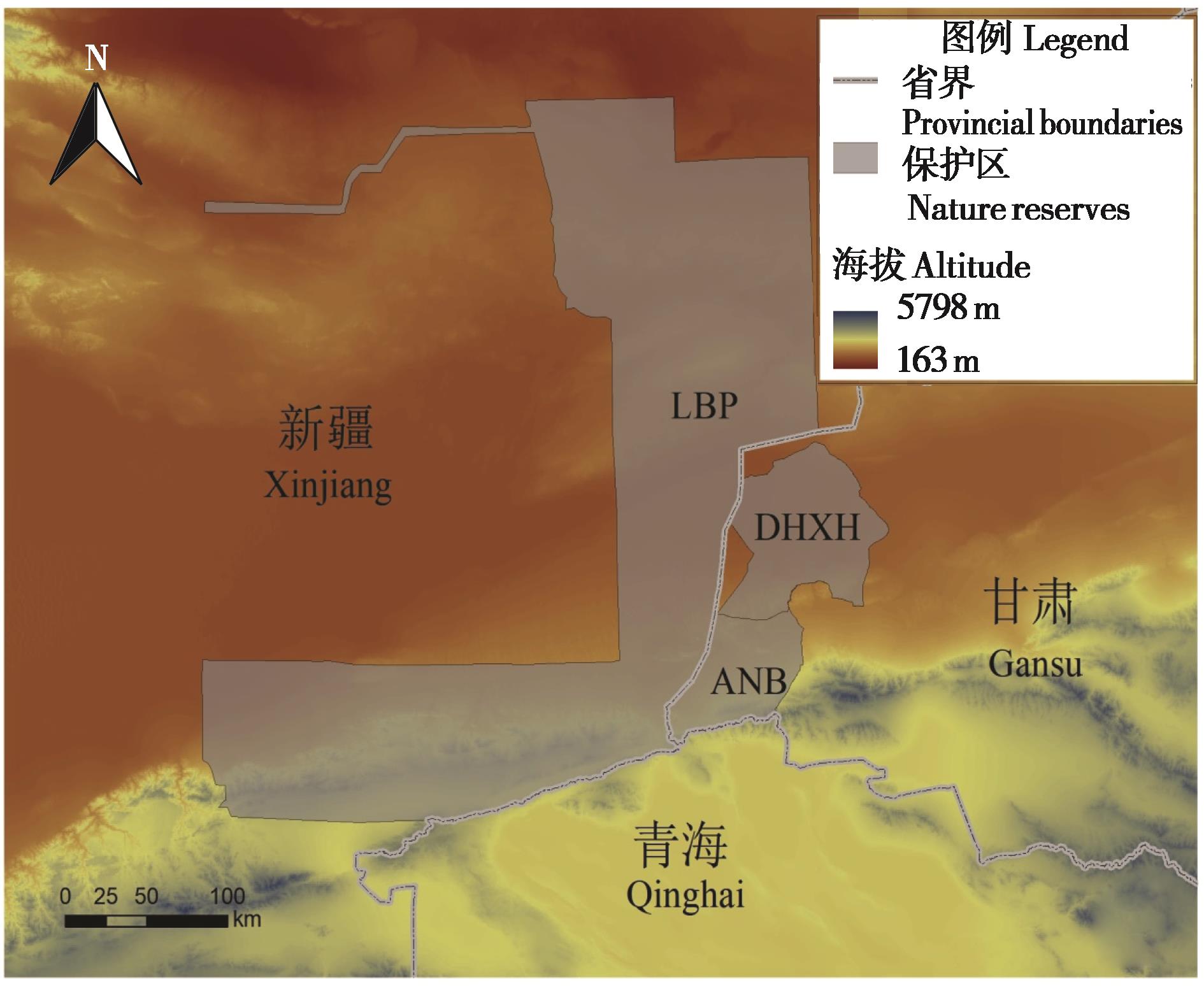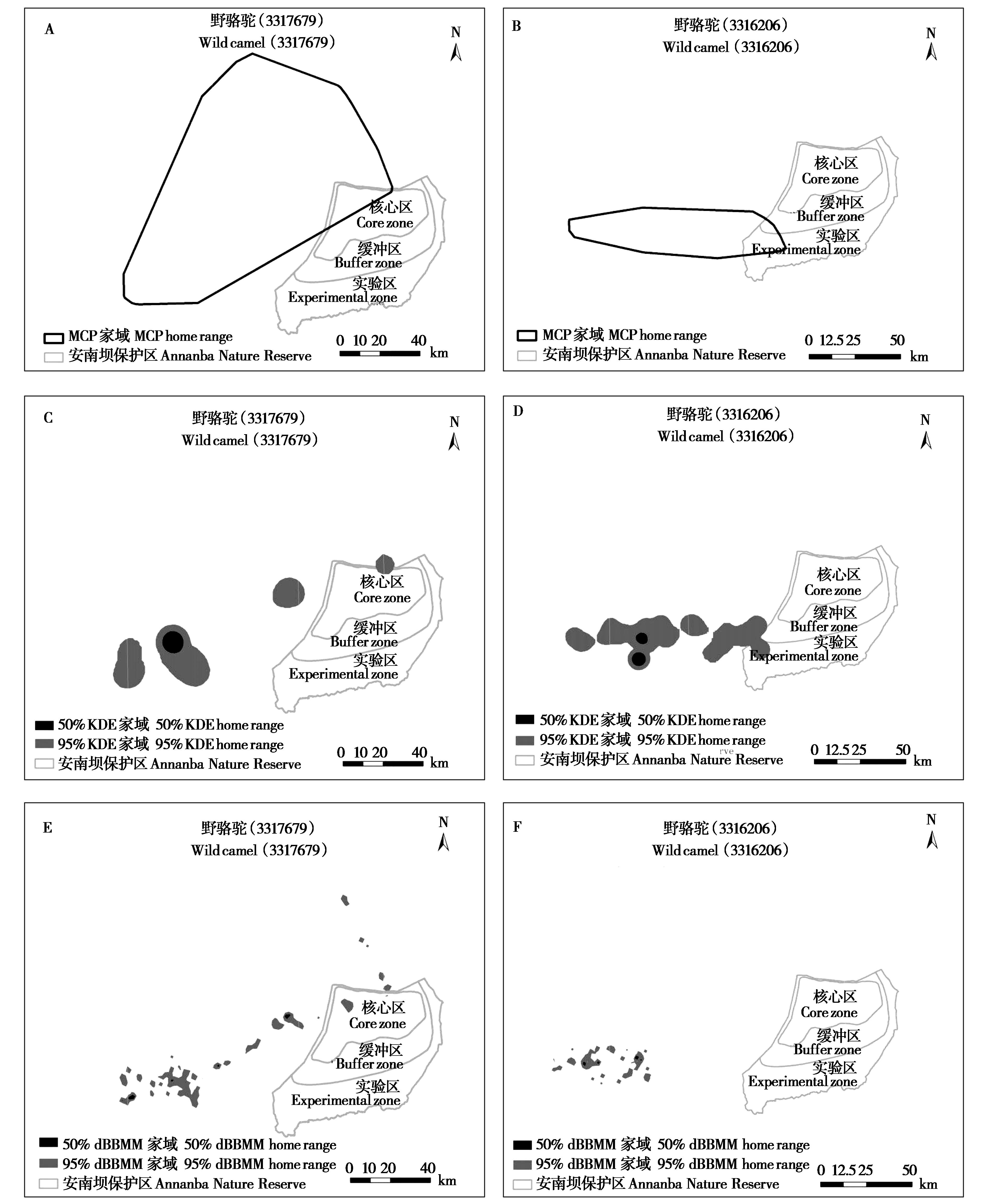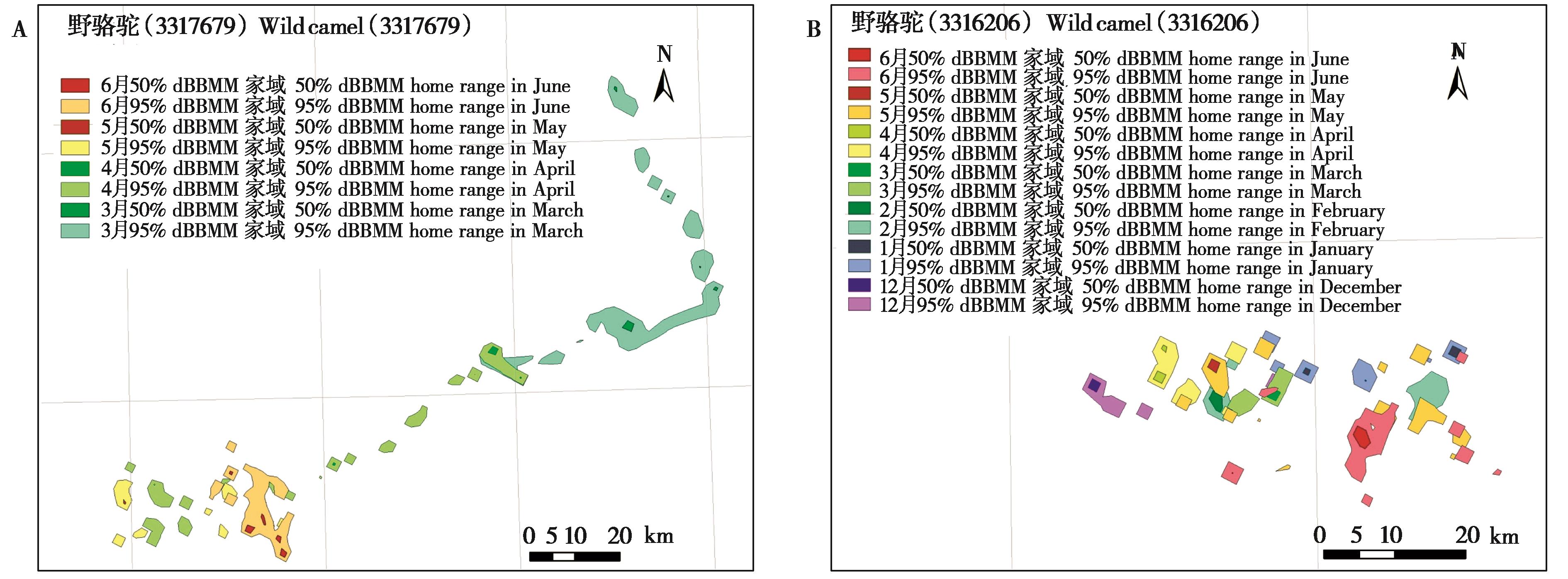

中国核心期刊要目总览
中国科技核心期刊
CSCD数据库源刊
中国科技核心期刊
CSCD数据库源刊


兽类学报 ›› 2023, Vol. 43 ›› Issue (1): 102-108.DOI: 10.16829/j.slxb.150672
周永祥1, 薛亚东2( ), 刘少创3, 刘建泉1, 周多良1
), 刘少创3, 刘建泉1, 周多良1
收稿日期:2022-03-30
接受日期:2022-07-05
出版日期:2023-01-30
发布日期:2023-01-10
通讯作者:
薛亚东
作者简介:周永祥 (1982- ),男,硕士研究生,主要从事野生动物保护研究.
基金资助:
Yongxiang ZHOU1, Yadong XUE2( ), Shaochuang LIU3, Jianquan LIU1, Duoliang ZHOU1
), Shaochuang LIU3, Jianquan LIU1, Duoliang ZHOU1
Received:2022-03-30
Accepted:2022-07-05
Online:2023-01-30
Published:2023-01-10
Contact:
Yadong XUE
中图分类号:
周永祥, 薛亚东, 刘少创, 刘建泉, 周多良. 利用不同家域计算方法对野骆驼栖息地空间利用的比较[J]. 兽类学报, 2023, 43(1): 102-108.
Yongxiang ZHOU, Yadong XUE, Shaochuang LIU, Jianquan LIU, Duoliang ZHOU. Wild camel space use as determined by different home range estimators[J]. ACTA THERIOLOGICA SINICA, 2023, 43(1): 102-108.

图1 研究区及周边区域示意图. ANB:甘肃安南坝野骆驼国家级自然保护区;LBP:新疆罗布泊野骆驼国家级自然保护区;DHXH:甘肃敦煌西湖国家级自然保护区
Fig.1 The map of study area and surrounding areas. ANB: Gansu Annanba Wild Camel National Nature Reserve; LBP: Xinjiang Lop Nur Wild Camel National Nature Reserve; DHXH: Gansu Dunhuang Xihu National Nature Reserve

图2 不同计算方法得出的野骆驼家域空间分布.A:编号3317679野骆驼的MCP家域;B:编号3316206野骆驼的MCP家域;C:编号3317679野骆驼的KDE家域;D:编号3316206野骆驼的KDE家域;E:编号3317679野骆驼的dBBMM家域;F:编号3316206野骆驼的dBBMM家域
Fig.2 Home range for wild camel 3317679 and 3316206 using different methods.A: MCP home range of 3317679 wild camel; B: MCP home range of 3316206 wild camel; C: KDE home range of 3317679 wild camel; D: KDE home range of 3316206 wild camel; E: dBBMM home range of 3317679 wild camel; F: dBBMM home range of 3316206 wild camel
月份* Month* | MCP家域 MCP home rang (km2) | 95% KDE家域 95% KDE home range(km2) | 50% KDE家域 50% KDE home range (km2) | 95% dBBMM家域 95% dBBMM home range (km2) | 50% dBBMM家域 50% dBBMM home range (km2) |
|---|---|---|---|---|---|
| 202103 | 4 930.92 | 1 460.12 | 225.39 | 294.92 | 6.52 |
| 202104 | 1 440.45 | 1 782.84 | 154.62 | 150.03 | 2.66 |
| 202105 | 556.34 | 417.01 | 40.29 | 75.86 | 2.59 |
| 202106 | 269.46 | 142.43 | 7.44 | 139.11 | 7.01 |
表1 不同月份编号3317679野骆驼活动范围
Table 1 Home range for 3317679 wild camel in different months
月份* Month* | MCP家域 MCP home rang (km2) | 95% KDE家域 95% KDE home range(km2) | 50% KDE家域 50% KDE home range (km2) | 95% dBBMM家域 95% dBBMM home range (km2) | 50% dBBMM家域 50% dBBMM home range (km2) |
|---|---|---|---|---|---|
| 202103 | 4 930.92 | 1 460.12 | 225.39 | 294.92 | 6.52 |
| 202104 | 1 440.45 | 1 782.84 | 154.62 | 150.03 | 2.66 |
| 202105 | 556.34 | 417.01 | 40.29 | 75.86 | 2.59 |
| 202106 | 269.46 | 142.43 | 7.44 | 139.11 | 7.01 |
月份 Month | MCP家域 MCP home range (km2) | 95% KDE家域 95% KDE home range(km2) | 50% KDE家域 50% KDE home range(km2) | 95% dBBMM家域 95% dBBMM home range (km2) | 50% dBBMM家域 50% dBBMM home range (km2) |
|---|---|---|---|---|---|
| 202012 | 351.42 | 313.81 | 44.02 | 23.11 | 1.86 |
| 202101 | 369.37 | 552.88 | 80.48 | 31.32 | 2.49 |
| 202102 | 631.50 | 798.57 | 90.61 | 40.66 | 3.81 |
| 202103 | 167.42 | 103.73 | 6.62 | 24.29 | 1.84 |
| 202104 | 381.88 | 371.48 | 36.60 | 36.10 | 2.26 |
| 202105 | 1 309.48 | 1 797.44 | 401.90 | 62.00 | 2.03 |
| 202106 | 1 291.45 | 982.32 | 186.32 | 60.20 | 4.68 |
表2 不同月份编号3316206野骆驼活动范围
Table 2 Home range for 3316206 wild camel in different months
月份 Month | MCP家域 MCP home range (km2) | 95% KDE家域 95% KDE home range(km2) | 50% KDE家域 50% KDE home range(km2) | 95% dBBMM家域 95% dBBMM home range (km2) | 50% dBBMM家域 50% dBBMM home range (km2) |
|---|---|---|---|---|---|
| 202012 | 351.42 | 313.81 | 44.02 | 23.11 | 1.86 |
| 202101 | 369.37 | 552.88 | 80.48 | 31.32 | 2.49 |
| 202102 | 631.50 | 798.57 | 90.61 | 40.66 | 3.81 |
| 202103 | 167.42 | 103.73 | 6.62 | 24.29 | 1.84 |
| 202104 | 381.88 | 371.48 | 36.60 | 36.10 | 2.26 |
| 202105 | 1 309.48 | 1 797.44 | 401.90 | 62.00 | 2.03 |
| 202106 | 1 291.45 | 982.32 | 186.32 | 60.20 | 4.68 |

图3 野骆驼dBBMM家域逐月分布.A:编号3317679野骆驼;B:编号3316206野骆驼
Fig.3 dBBMM home range for wild camels in different months. A: 3317679 wild camel; B: 3316206 wild camel
| Byrne M E, McCoy J C, Hinton J W, Chamberlain M J, Collier B A. 2014. Using dynamic Brownian bridge movement modelling to measure temporal patterns of habitat selection. Journal of Animal Ecology, 83: 1234-1243. | |
| Cagnacci F, Focardi S, Ghisla A, van Moorter B, Merrill E H, Gurarie E, Heurich M, Mysterud A, Linnell J, Panzacchi M, May R, Nygård T, Rolandsen C, Hebblewhite M. 2016. How many routes lead to migration? Comparison of methods to assess and characterize migratory movements. Journal of Animal Ecology, 85: 54-68. | |
| Fieberg J, Börger L. 2012. Could you please phrase ‘home range’ as a question? Journal of Mammalogy, 93: 890-902. | |
| Hare J. 2008. [2020-02-26]. Camelus ferus . The IUCN Red List of Threatened Species 2008: e.T63543A12689285. . | |
| Hemson G, Johnson P, South A, Kenward R, Ripley R, Mcdonald D. 2005. Are kernels the mustard? Datafrom global positioning system (GPS) collars suggests problems for kernel home‑range analyses with least-squares cross-validation. Journal of Animal Ecology, 74: 455-463. | |
| Horne J S, Garton E O, Krone S M, Lewis J S. 2007. Analyzing animal movements using Brownian bridges. Ecology, 88: 2354-2363. | |
| Kaczensky P, Adiya Y, von Wehrden H, Mijiddorj B, Walzer C, Güthlin D, Enkhbileg D, Reading R P. 2014. Space and habitat use by wild Bactrian camels in the Transaltai Gobi of southern Mongolia. Biological Conservation, 169: 311-318. | |
| Kranstauber B, Kays R, Lapoint S D, Wikelski M, Safi K. 2012. A dynamic Brownian bridge movement model to estimate utilization distributions for heterogeneous animal movement. Journal of Animal Ecology, 81: 738-746. | |
| Kranstauber B, Smolla M, Scharf A K. 2017. move: Visualizing and analyzing animal track data. R package version 3.0.1. . | |
| Nielson R M, Sawyer H, McDonald T L. 2013. BBMM: Brownian bridge movement model for estimating the movement path of an animal using discrete location data. R package version 3.0. . | |
| Core Development Team R. 2017. R: A language and environment for statistical computing. Vienna, Austria, URL . | |
| Silva I, Crane M, Suwanwaree P, Strine C, Goode M. 2018. Using dynamic Brownian bridge movement models to identify home range size and movement patterns in king cobras. PLoS ONE, 13 (9): e0203449. | |
| Tulgat R, Schaller G B. 1992. Status and distribution of wild Bactrian camels (Camelus bactrianus ferus). Biological Conservation, 62(1): 11-19. | |
| Wells A G, Blair C C, Garton E O, Rice C G, Horne J S, Rachlow J L, Wallin D O. 2014. The Brownian bridge synoptic model of habitat selection and space use for animals using GPS telemetry data. Ecological Modelling, 273: 242-250. | |
| Wells C R, Lethbridge M. 2020. Intensive and extensive movements of feral camels in central Australia. The Rangeland Journal, 42: 195-210. | |
| Wu Y J, Cheng Y, Yuan L, Zhang S, Zhang S, Liu S C. 2021. Quantitative study on the activity rhythm and home range of wild camels (Camelus ferus) in the Kumtag Desert. Biodiversity Science, 29 (9): 1206-1214. (in Chinese) | |
| Xue Y D, Li D Q, Xiao W F, Liu F, Zhang Y G, Wang X L, Jia H. 2015. Activity patterns of wild Bactrian camels (Camelus bactrianus) in the northern piedmont of the Altun Mountains, China. Animal Biology, 65 (3-4): 209-217. | |
| Xue Y D, Li J, Sagen G L, Zhang Y, Dai Y C, Li D Q. 2018. Activity patterns and resource partitioning: seven species at watering sites in the Altun Mountains, China. Journal of Arid Land, 10 (6): 959-967. | |
| Xue Y D, Li J, Li D Q. 2021. The wild camel (Camelus ferus) in China: Current status and conservation implications. Journal for Nature Conservation, 60: 125979. | |
| Xue Y D, Wu S X, Sun Z C, Guo T Z, Shala H, Li D Q. 2014a. Research and conservation of wild camel, present status and future prospects. Sichuan Journal of Zoology, 33 (3): 476-480. (in Chinese) | |
| Xue Y D, Liu F, Zhang Y G, Li D Q. 2014b. Grouping behavior of wild camel (Camelus ferus) referred from video data of camera trap in Kumtag Desert. Biodiversity Science, 22 (6): 746-751. (in Chinese) | |
| Xue Y D, Liu F, Guo T Z, Yuan L, Li D Q. 2014c. Using camera traps to survey wildlife at water sources on the northern slope of the Altun Mountains,China. Acta Theriologica Sinica, 34 (2): 164-171. (in Chinese) | |
| Xue Y D, Li D Q, Sun Z C, Yuan H F. 2017. Using satellite tracking collars to monitor released captive‑bred wild Bactrian camels. Acta Theriologica Sinica, 37 (4): 336-343. (in Chinese) | |
| Xue Y D, Li D Q, Li J. 2020. Habitat selection and migration pattern of wild Bactrian camel (Camelus ferus) in the Kumtag Desert, China based on satellite tracking and positioning technology. Scientia Silvae Sinicae, 56 (10): 192-198. (in Chinese) | |
| Xue Y D, Li J, Li D Q. 2021. Land use change and roadway-induced fragmentation in the historical distribution range of wild camel in the past 40 years. Acta Ecologica Sinica, 41 (20): 7965-7973. (in Chinese) | |
| Yuan L, Ma H, Cheng Y, Yang H, Sagen G L, Yadamsuren A, Zhu H Y, Ma Y Q, Wang J L, Zhang S, Ma X Y, Diao Q A, Liu S C. 2015. Qualitative study of wild camels (Camelus ferus) home range in Lop Nur, China. Biodiversity Science, 23 (3): 314-320. (in Chinese) | |
| 吴运佳, 程芸, 袁磊, 张诗, 张烁, 刘少创. 2021. 库木塔格沙漠地区野骆驼活动节律与家域特征. 生物多样性, 29 (9): 1206-1214. | |
| 薛亚东, 吴三雄, 孙志成, 郭铁征, 沙拉·哈那皮亚, 李迪强. 2014a. 野骆驼的研究和保护: 现状与展望. 四川动物, 33 (3): 476-480. | |
| 薛亚东, 刘芳, 张于光, 李迪强. 2014b. 利用红外相机视频数据进行库姆塔格沙漠地区野骆驼集群行为研究的可行性. 生物多样性, 22 (6): 746-751. | |
| 薛亚东, 刘芳, 郭铁征, 袁磊, 李迪强. 2014c. 基于相机陷阱技术的阿尔金山北坡水源地鸟兽物种监测. 兽类学报, 34 (2): 164-171. | |
| 薛亚东, 李迪强, 孙志成, 袁海峰. 2017. 利用卫星追踪颈圈对圈养野生双峰驼野化放归的监测.兽类学报, 37 (4): 336-343. | |
| 薛亚东, 李迪强, 李佳. 2020. 基于卫星追踪定位技术的库姆塔格沙漠野骆驼生境利用和迁移规律. 林业科学, 56 (10): 192-198. | |
| 薛亚东, 李佳, 李迪强. 2021. 近40年野骆驼历史分布区土地利用变化及生境破碎化驱动因素.生态学报, 41 (20): 7965-7973. | |
| 袁磊, 马浩, 程芸, 杨欢, 萨根古丽, Yadamsuren A, 朱海涌, 马友青, 王建林, 张烁, 马杏叶, 刁庆安, 刘少创. 2015. 罗布泊野骆驼的家域特征及其意义. 生物多样性, 23 (3): 314-320. |
| [1] | 李耀宇, 陈昕旸, 赵闪闪, 宋虓, 郭瑞, 徐爱春. 野外放归华南梅花鹿活动节律与家域特征[J]. 兽类学报, 2023, 43(5): 501-512. |
| [2] | 李亚东, 李博文, 王希, 李鹏晖, 李进华. 食物季节性对野生藏酋猴家域利用的影响[J]. 兽类学报, 2022, 42(6): 624-633. |
| [3] | 周永祥, 刘建泉, 周多良, 吴昊, 杨晓梅, 王天晖, 薛亚东. 甘肃安南坝野骆驼国家级自然保护区野骆驼利用人工水源点特征分析[J]. 兽类学报, 2022, 42(6): 634-640. |
| [4] | 吴采雯 江慧萍 张迪 朱林 郝秀青 张宏科 周煜 乔莹 张学雷 孙璐 杨光 陈炳耀. 北部湾涠洲岛水域发现上颌和须板异常的布氏鲸:对保护的启示[J]. 兽类学报, 2020, 40(4): 329-336. |
| [5] | 刘嘉辉 王艳 边坤 唐婕 王伟峰 郭林文 王波 方谷 赵兰 齐晓光. 重引入林麝的家域利用与个体迁移[J]. 兽类学报, 2020, 40(2): 109-119. |
| [6] | 袁耀华 刘群秀 张欣. 城市公园中赤腹松鼠的家域特征及昼间活动规律初探[J]. 兽类学报, 2019, 39(6): 639-650. |
| [7] | 薛亚东 李迪强 孙志成 袁海峰. 利用卫星追踪颈圈对圈养野生双峰驼野化放归的监测[J]. 兽类学报, 2017, 37(4): 336-343. |
| [8] | 端肖楠 初雯雯 王渊 杜聪聪 何雷 初红军. 新疆卡拉麦里山有蹄类自然保护区冬季狼的家域[J]. 兽类学报, 2016, 36(4): 452-458. |
| [9] | 徐信荣 陈炳耀 王炼 鞠建峰 杨光. 北部湾沙田水域中华白海豚和江豚的同域分布格局及时空变化[J]. , 2012, 32(4): 325-329. |
| [10] | 黄中豪, 周岐海, 黄乘明, 蒙渊君, 韦华. 广西弄岗黑叶猴的家域和日漫游距离[J]. , 2011, 31(1): 46-54. |
| [11] | 刘晓庆,王小明,王正寰,刘群秀,马波. 固定核空间法和最小凸多边形法估计藏狐家域的比较[J]. , 2010, 30(2): 163-170. |
| [12] | 刘群秀,王小明,王正寰. 藏狐家域功能分区及其生物学特性比较[J]. , 2009, 29(4): 432-438. |
| [13] | 刘群秀, 王正寰, 王小明. 两种核域估算方法在野生藏狐家域研究中的比较[J]. , 2009, 29(1): 26-31. |
| [14] | 刘群秀, Richard B. Harris, 王小明, 王正寰. 青海省都兰县藏狐家域范围及重叠度[J]. , 2007, 27(4): 370-375. |
| [15] | 王文 张静 马建章 刘海波. 小兴安岭南坡野猪家域分析[J]. , 2007, 27(3): 257-262. |
| 阅读次数 | ||||||
|
全文 |
|
|||||
|
摘要 |
|
|||||
 青公网安备 63010402000199号 青ICP备05000010号-2
青公网安备 63010402000199号 青ICP备05000010号-2